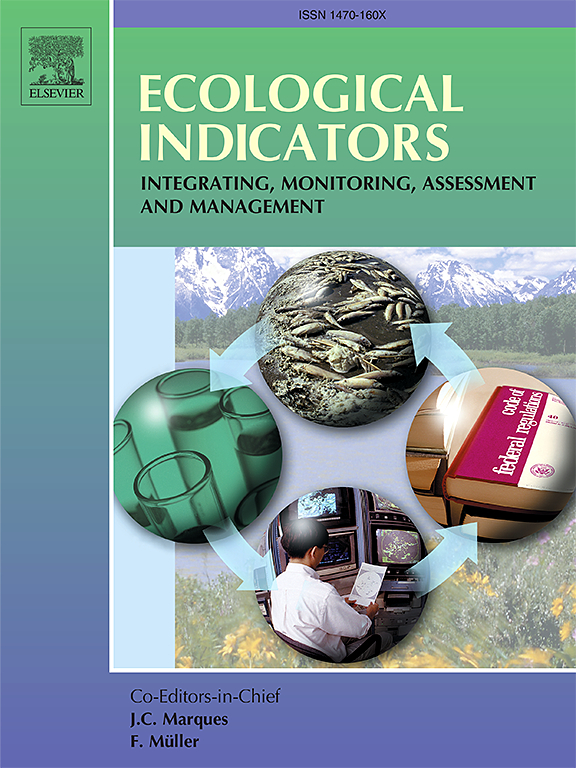Study on the water quality evolution mechanism of typical shallow lake based on in-depth mining of water quality indicators
IF 7
2区 环境科学与生态学
Q1 ENVIRONMENTAL SCIENCES
引用次数: 0
Abstract
The water quality (WQ) of Baiyangdian Lake (BYDL), known as the ‘kidney of North China’, declined continuously for about four decades from the 1980s because of socioeconomic development. Since the Xiong’an New Area was established in 2017, remediation efforts have been implemented and the WQ has improved. In this study, we analyzed six years of WQ data from BYDL using ordinary least squares regression, time series analysis, and the Mann-Kendall trend test. The results reveal a marked improvement in WQ since 2018, with Class III accounting for over 60 % of observations. There were significant decreasing trends in chemical oxygen demand, total nitrogen, total phosphorus, ammonia nitrogen, and Chlorophyll-a (p < 0.05) and an overall increasing trend in dissolved oxygen (p < 0.05). The WQ indicators varied seasonally. The WQ improvements generally aligned with the timing and patterns of the major engineering interventions but short-term fluctuations in the WQ indicators may have been caused by climatic variability. The findings highlight the complexity of the WQ pattens in BYDL and illustrate that the management strategy shifted from an initial phase that focused on pollution control to a second phase of ecological restoration integrated with environmental governance. This information can be used to refine future restoration strategies for BYDL and to guide sustainable management practices in similar shallow lake systems.
基于水质指标深度挖掘的典型浅湖水质演化机制研究
被称为“华北之肾”的白洋淀水质(BYDL)自20世纪80年代以来,受社会经济发展的影响,水质连续下降了近40年。自2017年雄安新区成立以来,整治力度不断加大,WQ得到提升。在本研究中,我们使用普通最小二乘回归、时间序列分析和Mann-Kendall趋势检验对BYDL六年的WQ数据进行了分析。结果显示,自2018年以来,WQ有了显著改善,III类占观察值的60%以上。化学需氧量、总氮、总磷、氨氮和叶绿素a (p <)呈显著下降趋势;0.05),溶解氧总体呈上升趋势(p <;0.05)。WQ指标随季节变化。水WQ的改善一般与主要工程干预的时间和模式一致,但水WQ指标的短期波动可能是由气候变化造成的。研究结果强调了青河区生态模式的复杂性,并说明管理策略从注重污染控制的初始阶段转向了生态恢复与环境治理相结合的第二阶段。这些信息可以用来完善BYDL未来的恢复策略,并指导类似浅湖系统的可持续管理实践。
本文章由计算机程序翻译,如有差异,请以英文原文为准。
求助全文
约1分钟内获得全文
求助全文
来源期刊

Ecological Indicators
环境科学-环境科学
CiteScore
11.80
自引率
8.70%
发文量
1163
审稿时长
78 days
期刊介绍:
The ultimate aim of Ecological Indicators is to integrate the monitoring and assessment of ecological and environmental indicators with management practices. The journal provides a forum for the discussion of the applied scientific development and review of traditional indicator approaches as well as for theoretical, modelling and quantitative applications such as index development. Research into the following areas will be published.
• All aspects of ecological and environmental indicators and indices.
• New indicators, and new approaches and methods for indicator development, testing and use.
• Development and modelling of indices, e.g. application of indicator suites across multiple scales and resources.
• Analysis and research of resource, system- and scale-specific indicators.
• Methods for integration of social and other valuation metrics for the production of scientifically rigorous and politically-relevant assessments using indicator-based monitoring and assessment programs.
• How research indicators can be transformed into direct application for management purposes.
• Broader assessment objectives and methods, e.g. biodiversity, biological integrity, and sustainability, through the use of indicators.
• Resource-specific indicators such as landscape, agroecosystems, forests, wetlands, etc.
 求助内容:
求助内容: 应助结果提醒方式:
应助结果提醒方式:


